Portable USB Nixie tube tester

Motivation
8 years after mine last project I once again had the urge to build another Nixie clock. And as we know, lamps are an essential element of every such clock.
They no longer produce such lamps (except for a few cases of hobbyists who bend numbers from wires in the privacy of their homes, encasing the whole thing in hot glass. So the only way is to buy some old copies from private people.
Purchasing used electronic components on aliexpress taught me that you should never trust and always check (test). The same may probably be true with lamps, but surprisingly these are easiest to get not in the Far East, but in our closer eastern neighbors (Ukraine, Russia). So I decided to build a handy lamp tester, powered by USB (!), so that I could, for example, connect it to a power bank and take it with me to a flea market before buying lamps.
The most popular in our country are probably the lamps from the domestic company DOLAM: LC-513 and LC-516. The latter are basically the same as the former, but covered with resin in the plinth. I heard that some people have the ability to cut this ebonite "filth" and remove the lamp. But in the "clothes" both lamps have different pinout, so I decided to create two testers.
Description of the device
The whole thing is managed by the only integrated circuit on board: Atmega 8. And it`s not boring at all, because in addition to controlling the cathodes, it also serves as a voltage converter. And it`s not easy - increasing 5V from USB to 180V was implemented in the form of a simple Boost converter. PWM frequency is 31.2 kHz, duty cycle is 85%. The increased output voltage is monitored by the microcontroller with one of the ADC inputs, thanks to which the feedback keeps the output voltage at a set level.
Although I tested even without feedback and in this system I was not able to get more than about 180V (without load). Maximum current efficiency approx. 1.2 mA.
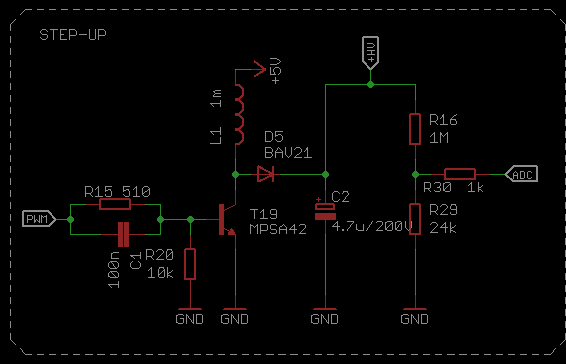
The microcontroller is clocked with an external 16 MHz crystal for USB purposes - because the system uses USB not only for power, but also has the ability to communicate with a computer. Using a PC, you can, for example, read the voltage produced by the converter when powering various cathodes, so you can detect, without looking, which of the cathodes have any problems (e.g. they do not light up at all or consume excessive current).
There is also a button - by default, when turned on, the device displays each digit in a circle. However, by pressing the button you can change the control to manual, thus keeping a given digit longer.

As a socket for the LC-513 lamps, I used extended connectors from the DB socket. They work perfectly.
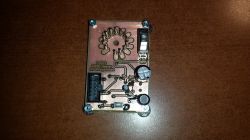
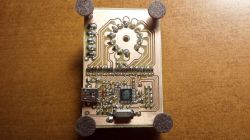
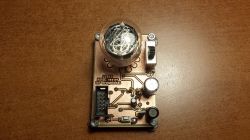

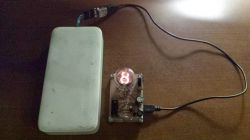
DownI used a dedicated stand for the LC-516 lamp, but I am not satisfied with it - quite a lot of force is needed to place the lamp in it.
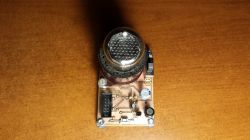

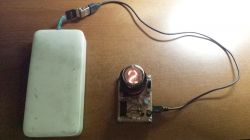
Fortunately, there are also single pins with a thicker diameter on Aliexpress, which I will probably replace in the future:

https://pl.aliexpress.com/item/1005004071932217.html
And finally, a comparison of both testers - it is basically an identical design, the difference is only in the upper part of the board on which the tested lamp is placed. Thanks to the use of SMD elements, the device is very small and handy. Some more casing would be useful...
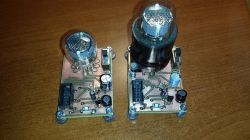
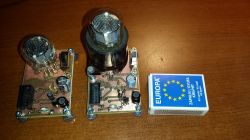
As an interesting fact, it took me half a day to build the second one - the microcontroller was unable to generate high voltage, it reset itself if I changed the fill factor in the interrupt function. After replacing it with another identical chip, the problem disappeared.
Heh, now it`s time to create an atmeg tester from aliexpress.
I noticed that most of the lamps, when turned on for the first time after many years, glow "sluggishly" - some of the digits seem to have missing fragments. Only after a dozen or so seconds everything starts to "normalize" and the lamp, put aside and then tested, e.g. after an hour, works normally. So it is not some form of "heating up", but rather a phenomenon known as cathode poisoning - some oxides are deposited on the cathodes, which are "dusted" back from them only after some time. Apparently, when displaying digits on such lamps, it is worth displaying all the digits one by one from time to time to eliminate this phenomenon.



Comments
Cool project - I would love to see a version in the form of one board and plug-in adapters depending on the lamp being tested I must disagree with this statement ;-) Below are the website addresses... [Read more]
Thanks for sharing your project. If you send me a parcel locker, I will give you a small gift! [Read more]
An interesting phenomenon. But where do the oxides come from if it`s a vacuum tube? I think it`s something else. Maybe my colleague @AlekZ will say something more about this interesting topic. [Read more]
The current appearance of the project does not exclude the use of adapters - they will have male DB contacts in the shape of a circle (like contacts in a lamp), instead of "goldpins". People designing... [Read more]
Not true. Dalibor Farny, and additionally a milclock factory in Ukraine. The former makes new models of nixie tubes from scratch. This second factory only produces one type, the modernized IN-18 as... [Read more]
We`re talking chatter here, and Tiktok gave me this beauty [Read more]
Well, I wrote it in the first post, which was a comment on the author`s entry :D [Read more]
I had a lot of new Z573M (not as big as IN-18), I sold one collective package (200 pieces) with difficulty two years ago for PLN 20/piece, now even PLN 35/piece for these NEW IN PERFECT CONDITION NIX,... [Read more]
This is a gas lamp, a neon lamp to be precise. Perhaps it would be enough to reduce the lamp current, e.g. by increasing the value of the anode resistors? Reducing the voltage will not necessarily... [Read more]